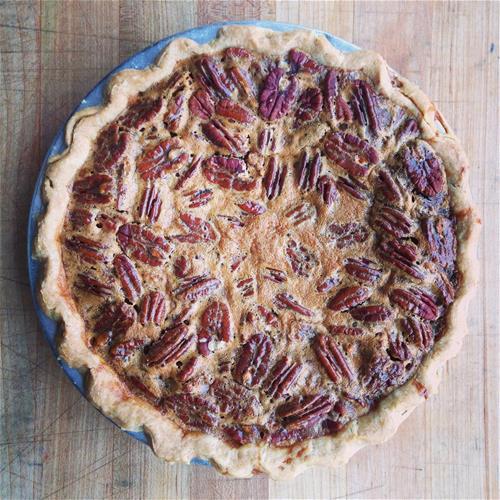It’s not as traditional as pumpkin pie, or as familiar as apple pie, but I’m going to go ahead and say it: pecan pie is the ideal Thanksgiving dessert. It has deep American roots. It has warm, caramel, nutty flavor. And while it’s fancy enough for a holiday spread, it’s also homey enough to serve any Thursday evening, all year round.
As American as pecan pie?
I know, I know, that’s not how the saying goes. But maybe it should be. Apples have their origins in central Asia. Pecans, on the other hand, are native to the Mississippi river basin—especially in eastern Oklahoma and Texas. They’ve been eaten by Native Americans for millennia. They were also popular with our founding fathers. In 1775, in addition to being named Commander in Chief of the Continental Army, George Washington found the time to plant a few pecan trees at his home, Mount Vernon. Story has it they were a gift from Thomas Jefferson, who planted a few of his own pecan trees at Monticello.
While Washington and Jefferson were snacking on pecans, they probably didn’t eat any pecan pie. The first recipe for pecan pie didn’t show up until a century later, when Harper’s Bazaar published this snippet in 1886. Over the next few decades pecan pie recipes popped up in various publications—especially in pecan-rich Texas—including Texas Siftings, the Dallas Morning News, and the Lone Star Cook Book. But it wasn’t until the 1930s, when the corn syrup makers at Karo started publishing pecan pie recipes left and right in ads and cookbooks, that pecan pie was established as a staple on the American pie scene—especially in the south.
Speaking of corn syrup, let’s chat about it for a minute. It gets a bad rap as the unhealthiest and most evil of the sweeteners. And while it’s true that industrially produced high fructose corn syrup isn’t the best for your health or the environment, plain old regular corn syrup has been part of the American culinary scene since at least the Civil War. These days, it’s a boon to candy makers and bakers because unlike other sweeteners, corn syrup doesn’t crystallize. That means it helps to create a soft, gooey texture. For that reason, practically every pecan pie out there is made with a bit of corn syrup—including ours.
To make our pecan pie, we start with really good pecans—tons of ‘em.
Unlike other pecan pies where there’s a paltry layer of pecans on top of a custardy filling, the Zingerman’s pie is so crammed full of pecans that there’s hardly room for the custard. We use huge whole pecans—the official name for the size is “mammoth halves.” They come from an association of orchards across the southern US that focuses on two varieties of pecans, Western Schley and Pawnee, both of which are known for their good flavor.
To make the filling, the primary sweetener we use is Muscovado brown sugar. Most brown sugar is actually bland white sugar with a little molasses added back in. Muscovado brown sugar, on the other hand, never had the molasses removed. It has incredible depth of flavor, with sweet notes like caramel and toffee as well as darker flavors that almost hint at smokiness. It gives a rich, complex, caramelly sweetness to the pecan pie.
Both the pie crust and the filling are made with real butter. That might not sound that special, but the reality is that practically all bakeries making pies on any scale use shortening, not butter. There are two reasons for that. For starters, butter is more expensive, so using shortening cuts down on costs. Shortening is also a lot easier to work with. Butter has a fairly low melting point—around 95°F. Shortening, on the other hand, melts around 118°F. That means butter can melt in your hands, but shortening can’t, so it’s easier to make a dough with shortening. However, it also means that butter can melt in your mouth but shortening can’t. Pastries made with shortening will never have that delicate, melt in your mouth texture that you get from butter. The flavor of butter is also richer and more luscious than shortening, which typically has as about as much flavor as vegetable oil—which makes sense, because that’s basically what it’s made of.
All the little steps add up to make a seriously flavorful pie. When people try it they usually compare it to pecan pies they’ve had in the south—and ours has won more than a few converts.
While pecan pie is good at any temperature, it’s magical when served warm.
It’s also good at any time of day—for the truly dedicated, it’s the ultimate Thanksgiving breakfast. To make it even more decadent, top it with a dollop of freshly whipped cream or a scoop of good ice cream. To heat it up, just give it ten minutes in a 350 degree oven.
We ship them in a reusable metal tin, and you could heat it up and serve it in that. But if you want to pass it off as your own, before you warm it just pop it out of our tin and into your own pie plate—and remember to hide the packaging. Go ahead, we don’t mind—it’ll be our little secret.

